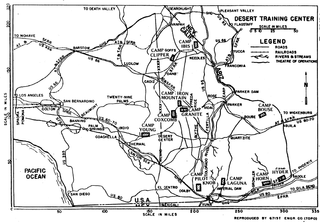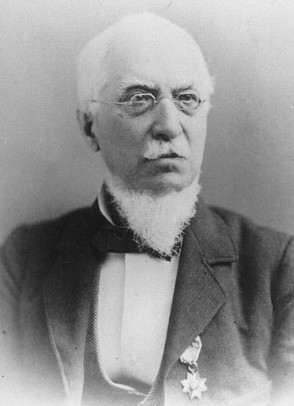Related Research Articles

The Victor Valley is a valley in the Mojave Desert and subregion of the Inland Empire, in San Bernardino County in Southern California.

Located in Los Angeles County, California's San Gabriel Valley, the Boy Scouts of America's San Gabriel Valley Council (#40) was one of five councils serving Los Angeles County. It was headquartered in Pasadena.

California's involvement in the American Civil War included sending gold east to support the war effort, recruiting volunteer combat units to replace regular U.S. Army units sent east, in the area west of the Rocky Mountains, maintaining and building numerous camps and fortifications, suppressing secessionist activity and securing the New Mexico Territory against the Confederacy. The State of California did not send its units east, but many citizens traveled east and joined the Union Army there, some of whom became famous.

Alta Loma is one of three unincorporated areas that became part of the city of Rancho Cucamonga, California, United States in 1977. The community is located at 34.15°N 117.60°W in the foothills of the south face of the San Gabriel Mountain range, near Cucamonga Peak and Mount San Antonio. Its ZIP codes are 91701 and 91737. Elevation ranges from 1,400 feet (430 m) to 3,000 feet (910 m). The name comes from the Spanish words for "high hill." Alta Loma had previously been known as "Iamosa".

The Pacific coast theater of the American Civil War consists of major military operations in the United States on the Pacific Ocean and in the states and Territories west of the Continental Divide. The theater was encompassed by the Department of the Pacific that included the states of California, Oregon, and Nevada, the territories of Washington, Utah, and later Idaho.
Wildwood Canyon is a canyon and California state park in the eastern foothills of the San Bernardino Mountains, within San Bernardino County, southern California.

Norton Air Force Base (1942–1994) was a United States Air Force facility 2 miles (3.2 km) east of downtown San Bernardino in San Bernardino County, California.

The Mojave Road, also known as Old Government Road, is a historic route and present day dirt road across what is now the Mojave National Preserve in the Mojave Desert in the United States. This rough road stretched 147 miles (237 km) from Beale's Crossing, to Fork of the Road location along the north bank of the Mojave River where the old Mojave Road split off from the route of the Old Spanish Trail/Mormon Road.

Founded in 1915, the Greater Los Angeles Area Council (GLAAC) (#033) served most of the City of Los Angeles as well as several other cities in the greater Los Angeles area. It was one of five Boy Scouts of America councils in Los Angeles County, California. Since its founding in 1915, the Los Angeles Area Council has brought its purpose and values to millions of youth. The Council served 54,567 youth in the Greater Los Angeles Area in 2008 alone.

The District of Southern California was a 19th-century district of Department of the Pacific, a command of the United States Army.
The District of California was a Union Army command department formed during the American Civil War. The district was part of the Department of the Pacific, the commander of the department also being District commander. The district was created as a separate command on July 1, 1864, after Irvin McDowell took command of the Department of the Pacific, relieving General Wright, who then remained as District of California commander. The District comprised the state of California and the areas of the Rogue River and Umpqua River in Southern Oregon. Its headquarters were in San Francisco, co-located with those of the Department of the Pacific. On March 14, 1865, the District of Oregon was extended to include the entire state of Oregon, removing the Rogue River and Umpqua River areas from the District.
Camp Lyon, sometimes called Fort Lyon, was established March 1862 as a temporary California Volunteer post located about 20 miles southeast of Arcata, California on the right bank of the Mad River at Brehmer's Ranch, opposite Blue Slide Creek near Kneeland, California. Company K, 2nd Regiment California Volunteer Infantry was ordered to Camp Lyon December, 1861, and served there until the fort was abandoned.

The Department of California was an administrative department of the United States Army. The Department was created in 1858, replacing the original Department of the Pacific, and it was ended by the reorganizations of the Henry L. Stimson Plan implemented in February 1913. As with the preceding organization, headquarters were in San Francisco. Its creation was authorized by General Orders, No. 10, of the War Department, Adjutant-General's Office, September 13, 1858.

The Desert Training Center (DTC), also known as California–Arizona Maneuver Area (CAMA), was a World War II training facility established in the Mojave Desert and Sonoran Desert, largely in Southern California and Western Arizona in 1942.
Camp Guild is a former World War I mobilization camp that existed in 1917 in Boxford, Massachusetts. It was named for Curtis Guild Jr., the governor of Massachusetts (1906–1909). Established in World War I and used for an unspecified time thereafter for mustering Massachusetts National Guard troops. In 1926 Camp Curtis Guild was acquired and named by the Commonwealth at another location, thus this camp was presumably defunct by then.
Camp Adams was a former American Civil War training camp that existed in 1861 in Quincy, Massachusetts. It was first occupied on 5 July 1861 by Cobb's Light Artillery. On 8 August the unit relocated to Baltimore, Maryland and established Camp Andrew.

Camp Cady was a U.S. Army Camp, on the Mojave Road near the Mojave River in the Mojave Desert, located about 20 miles east of modern-day Barstow, California in San Bernardino County, at an elevation of 1690 feet. Camp Cady was named after Major Albemarle Cady, 6th Infantry Regiment, who was a friend of Carleton and commander at Fort Yuma in 1860.

The Mojave Road Los Angeles was designated a California Historic Landmark on March 19, 1985. It runs from Drum Barracks in Los Angeles County to the Colorado River in San Bernardino County, California.

Albemarle Cady was a career United States Army officer who served in the Second Seminole War, Mexican–American War, First Sioux War and the American Civil War. During the Civil War, he was briefly lieutenant colonel of the 7th Infantry Regiment. He then served in administrative positions in the Department of the Pacific, including the District of Oregon. He received brevet appointments for his service in the Mexican–American War and the Civil War. He retired from the Regular Army as a colonel on May 18, 1864. On July 17, 1866, President Andrew Johnson nominated and on July 26, 1866, the United States Senate confirmed the appointment of Cady as a brevet brigadier general in the Regular Army, to rank from March 13, 1865.

Before Camp Latham or Camp Drum existed in the District of Southern California during the American Civil War there was Camp Fitzgerald, located somewhere near downtown Los Angeles. Camp Fitzgerald was organized sometime after May 3 and before October 1861 by James H. Carleton out of Fort Tejon. Camp Fitzgerald was named for Edward H. Fitzgerald, a U.S. Army Major who had himself established Fort Jones but had died of consumption in January 1860. The New York Times mentioned the establishment of the camp, which then had four companies of men, on July 31, 1861: "...four companies of United States regulars were recalled from neighboring stations, and now occupy tents fronting the city named."
References
- ↑ "The History". Camp Carleton Cornet Band. Archived from the original on February 29, 2024. Retrieved 2024-02-29.
- ↑ Roberts, Robert B. (1988). Encyclopedia of historic forts : the military, pioneer, and trading posts of the United States. Internet Archive. New York : Macmillan ; London : Collier Macmillan. pp. 64–65. ISBN 978-0-02-926880-3.
- ↑ The California State Military Museum, Historic California Posts: Camp Carleton (Camp Banning, Camp Prentiss, New Camp Carleton)